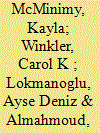| Srl | Item |
| 1 |
ID:
191056


|
|
|
|
|
| Summary/Abstract |
Recognizing that militant, non-state groups utilize social media and online platforms to reach members, sympathizers, and potential recruits, state agencies and social media corporations now increasingly regulate access to accounts affiliated with such groups. Scholars examining deplatforming efforts have, to date, focused on the extent of audience loss after account restrictions and the identification of strategies for regrouping online followers on the same or different platforms over time. Left unexplored is if and how militant non-state groups adapt their official messaging strategies in response to platform restrictions despite continuing online access to them. To begin to fill that gap, this study compares ISIS’s 550 images displayed in the group’s official newsletter al-Naba six months before and after Europol’s November 2019 take-down of terrorist affiliated accounts, groups, channels, and bots on Telegram. It conducts a content analysis of images related to militaries and their outcomes, non-military activities and their outcomes, and presentational forms. The findings demonstrate that ISIS visually emphasizes its standard priming approach but shifts its agenda-setting strategy. While retaining some of its standard visual framing practices, the group also alters frames, particularly those related to images showing opposing militaries and military outcome.
|
|
|
|
|
|
|
|
|
|
|
|
|
|
|
|
| 2 |
ID:
182976


|
|
|
|
|
| Summary/Abstract |
This article explores how competing actors established, spread, and challenged visual representations of the Chinese nation during the COVID-19 pandemic. It asks: how do official gatekeepers of meaning in China imbue their visual construction of a crisis-hit nation with pathos?; and what happens when their critics utilize the resulting repertoire of visual cues for their own ends? To answer these questions, the article first examines the visual libraries of nationalism and national crisis from which Chinese propaganda drew during the COVID-19 outbreak. It then analyses the struggles that ensued over such representations, specifically the use of national flags and the sentiments they elicit. The analysis traces representations of the flag of the People’s Republic of China (PRC) from an initial satirical portrayal in a Danish broadsheet to the angry Chinese backlashes that followed on social media, and it shows how the tensions over such portrayals became part of a meme war over the sovereignty of Hong Kong. The analysis shows how representations of the nation can become a matter of existential anxieties during a time of crisis, especially in highly networked communication environments where authoritative official actors and their supporters are no longer in control of the symbols they established as part of their ‘emotional governance’.
|
|
|
|
|
|
|
|
|
|
|
|
|
|
|
|
| 3 |
ID:
092445


|
|
|
|
|
| Publication |
2009.
|
| Summary/Abstract |
This article focuses on the production and dissemination of photographic images by serving US soldiers in Iraq who are photographing their experiences and posting them on the Internet. This form of visual communication - in real time and communal - is new in the representation of warfare; in earlier wars soldiers took photographs, but these were not immediately shared in the way websites can disseminate images globally. This digital generation of soldiers exist in a new relationship to their experience of war; they are now potential witnesses and sources within the documentation of events, not just the imaged actors - a blurring of roles that reflects the correlations of revolutions in military and media affairs. This photography documents the everyday experiences of the soldiers and its historical significance may reside less in the controversial or revelatory images but in more mundane documentation of the environments, activities and feelings of American soldiery at war.
|
|
|
|
|
|
|
|
|
|
|
|
|
|
|
|